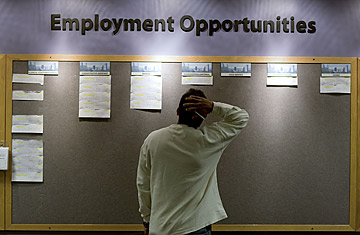
A man looks at job postings at a Denver Workforce Center on Nov. 5, 2008
Using the U.S. government's count, about 2.4 million Americans lost their jobs last year. That does not include people who had been jobless for an extended period and were no longer looking for jobs. In January, another 598,000 people were put onto the streets by their employers, moving the unemployment rate up to 7.6%.
According to MarketWatch, the average forecaster thinks the economy shed 640,000 jobs last month. Some estimates are well over 700,000. The impression that the employment situation is getting worse was confirmed by Ben Bernanke's testimony before the Senate yesterday. (See pictures of the global financial crisis.)
Analysts may admit to a frightening February unemployment rate, but most either believe that the economy is going to get better or don't want to say in public what they think. While it is comforting to claim that the February numbers will be a high-water mark for employment erosion, that may not be the case. The joblessness rate could thunder higher between now and the year's end.
During the 1980-82 recession, unemployment went from 7.9% in October 1981 to 10.1% the following September. Two months later, it hit 10.8%. The notion that 10% unemployment will not arrive until next year, if it comes at all, is bogus.
The proposition that the stimulus package and new budget will create jobs may be true. It is also true that not enough money will reach companies to have much impact on their hiring this year. No one knows whether the programs will work. Since they are untested, particularly in an economy this large that is destroying itself this fast, trying to assess their chances of success is as tough as making a winning wager on which dog team will win the Iditarod.
The most important business dynamic that works against job creation in an economy dropping this quickly is the fact that every worker is a consumer. Layoffs set in motion a vicious cycle that undermines a major pillar of any expansion. Consumer confidence drives the process that is the largest single component of GDP. In this recession, the trouble is compounded by an unprecedented lack of access to credit because of housing prices and the near failure of the banking system. (See pictures of office cubicles around the world.)
The other root cause that bedevils any attempt to improve the job situation is that private enterprise is suffering from an unusually rapid loss of earnings. Corporate bankruptcies are beginning to rise sharply, and even companies that have been considered rock-solid, such as GE (GE) and Microsoft (MSFT), admit that their core businesses are being hurt badly and are coy about when they think the situation will improve. Large companies have gotten into the habit of saying that they cannot forecast earnings because they have "limited visibility." In most cases that means they cannot predict their sales beyond the current quarter. (See pictures of Bill Gates' early years.)
The monthly average increase in unemployment this year could be 650,000 to 700,000 jobs. Between the end of last year and next January, 8 million people could be put out of work. The fact that the number is staggering does not make it improbable.
The government's plan to create jobs is not set up to cope with a situation in which jobs are lost at a rate of 2 million per quarter. Even advocates of tax cuts would have to admit that the money any cuts would add to business and consumer wallets would not make much difference in the next several months. That may be academic. The Administration is proposing a modest cut for most people, but it is just that — a modest cut. Businesses that will be taxed at a higher rate will have to decide whether that drain affects how many people they'll have on their payrolls.
The market may have to go through the tragedy of a self-correction that combines agony and duration. The economy may run through a cycle in which unemployment increases until labor costs fall to a nearly unimaginable level. Businesses will begin to hire again because they will have access to skilled workers at a fraction of what those people would have cost them a year ago. If that is the solution to the labor problem, the end of the recession is a long way from here.
— Douglas A. McIntyre
See 25 people to blame for the financial crisis.
For constant business updates, go to 24/7wallst.com.
